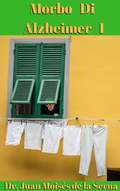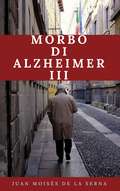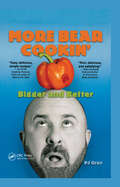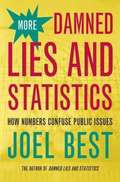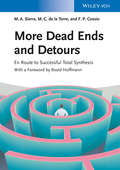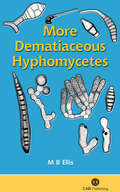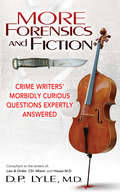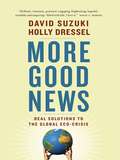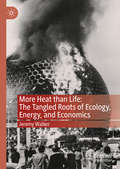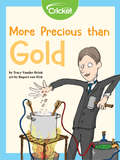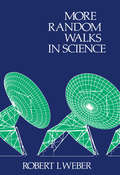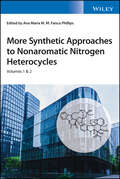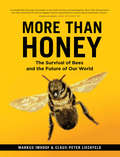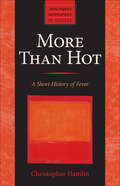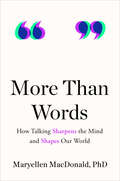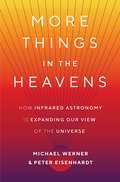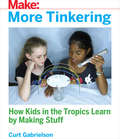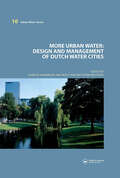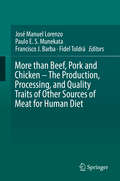- Table View
- List View
Morbo Di Alzheimer II
by Juan Moises de la Serna Elisabetta MannoniL’obiettivo di questo e-book è servire da primo avvicinamento per coloro che vivono in prima persona o all’interno della loro famiglia la malattia di Alzheimer. Questo libro prova a presentare in modo chiaro i risultati delle ultime ricerche sulla malattia di Alzheimer, al fine di rispondere alle domande più importanti: che sintomi provoca? come viene diagnosticato? quanti ne sono affetti?
Morbo di Alzheimer - I
by Juan Moises de la Serna Matteo SerragoL'e-book "morbo di Alzheimer - I" spiega in maniera più semplice e con un linguaggio alla portata di tutti il morbo di Alzheimer, la famosa malattia neurodegenerativa da tutti conosciuta per i suoi irreversibili danni alla memoria. Questo e-book offre quindi una spiegazione chiara ed efficace di come la malattia si sviluppa, se ha cause genetiche, chi viene colpito maggiormente e quali sono gli sforzi che la scienza fa ogni giorno per cercare di arginare un male tanto temuto quanto difficile da curare.
Morbo di Alzheimer III
by Juan Moises de la SernaCome viene trattato? Qual è la sua evoluzione? Come si previene? Scopri gli ultimi progressi nella prevenzione e nel trattamento della malattia di Alzheimer. Uno segli aspetti importanti di una malattia è come superarla, curarla e il suo trattamento. A questo proposito sono stati effettuati progressi nel campo della ricerca sul trattamento e la prevenzione della malattia di Alzheimer, presentati in qusto testo. Destinatari: - Professionisti della salute che desiderano approfondire le proprie conoscenze sulla signosi e sul trattamento della malattia di Alzheimer. - Insegnanti che vogliono offrire informazioni aggiornate sulla malttia di Alzheimer ai loro studenti. - A tutti coloro che soffrono della malattia di Alzheimer e i loro parenti, in modo che sappiano comportarsi di fronte a questa malattia. In seguito vengono presentati gli argomenti principali di questo testo: - Trattamento dell'Alzheimer: nonostante la limitata efficacia dei trattamenti attuali, ogni giorno vengono fatte nuove scoperte per affrontare questa malattia. - Evoluzione del morbo di Alzhiemer: il morbo di Alzheimer è definito come una malattia progressiva, cioè, col tempo, si perdono le capacità cognitive di coloro che ne soffrono. Scopri come combatterlo. Prevenzione del morbo di Alzheimer: questo è probabilmente uno degli aspetti più sconosciuti delle ultime scoperte sul morbo di Alzheimer.
More Adventures in Contemporary Electromagnetic Theory
by Francesco Chiadini Vincenzo FiumaraThis book describes some recent advances in electromagnetic theory, motivated and partly informed by developments in engineering science and nanotechnology. The collection of chapters provided in this edited book, authored by leading experts in the field, offers a bird’s eye view of recent progress in electromagnetic theory, spanning a wide range of topics of current interest, ranging from fundamental issues to applications.
More Bear Cookin': Bigger and Better
by PJ GrayMake your kitchen more bearable to burly men with big appetites!Loosen your belts and make room for seconds! PJ Gray, author of Bear Cookin’: The Original Guide to Bear Comfort Foods, is back with More Bear Cookin’: Bigger and Better, serving up another helping of mouth-watering recipes, handy kitchen tips, and tributes to comfort foods. Seasoned with humor and served with a side order of fun, this flavorful collection combines favorites like Use Your Tool and More Bearable Meal Suggestions from the original book with new food and information features like Did Ya Know? and Kitchen Tips. The book also includes a glossary of cooking technology, recipe measures and equivalencies, and emergency ingredient substitutions.Home-style cooking holds a special place in the hearts (and bellies) of bears, who can take comfort in the hearty fare found in the personal and family recipes presented in More Bear Cookin’: Bigger and Better. Find everything you need for three squares a day - and all snacks in between - in sections like Lip Smackin’ Snackin’, Woofy Breakfast, More Hearty Sides, Come-and-Get-It Entrees, More Bear Meat, and Way Beyond the Honey Pot. The book offers practical tips about food preparation, cooking and storage, how to cook a holiday turkey, how to work with sugar, syrup, and honey, and refrigerator care and maintenance. More Bear Cookin’ also pays loving tribute to the magical powers of peanut butter, eggs, potatoes, cheese, mayonnaise, meat broth, and chocolate, dishes on Diner Talk (waiter/waitress lingo), and Leftover Life (general rules for food safety), and gives up The Skinny on Fat (cooking with fats and oils).More Bear Cookin’: Bigger and Better includes such rich, satisfying reci
More Damned Lies and Statistics: How Numbers Confuse Public Issues
by Joel BestIn this sequel to the acclaimed "Damned Lies and Statistics," which the Boston Globe said "deserves a place next to the dictionary on every school, media, and home-office desk," Joel Best continues his straightforward, lively, and humorous account of how statistics are produced, used, and misused by everyone from researchers to journalists. Underlining the importance of critical thinking in all matters numerical, Best illustrates his points with examples of good and bad statistics about such contemporary concerns as school shootings, fatal hospital errors, bullying, teen suicides, deaths at the World Trade Center, college ratings, the risks of divorce, racial profiling, and fatalities caused by falling coconuts. "More Damned Lies and Statistics" encourages all of us to think in a more sophisticated and skeptical manner about how statistics are used to promote causes, create fear, and advance particular points of view. Best identifies different sorts of numbers that shape how we think about public issues: missing numbers are relevant but overlooked ;confusing numbers bewilder when they should inform; scary numbers play to our fears about the present and the future; authoritative numbers demand respect they don't deserve; magical numbers promise unrealistic, simple solutions to complex problems; and contentious numbers become the focus of data duels and stat wars. The author's use of pertinent, socially important examples documents the life-altering consequences of understanding or misunderstanding statistical information. He demystifies statistical measures by explaining in straightforward prose how decisions are made about what to count and what not to count, what assumptions get made, and which figures are brought to our attention. Best identifies different sorts of numbers that shape how we think about public issues. Entertaining, enlightening, and very timely, this book offers a basis for critical thinking about the numbers we encounter and a reminder that when it comes to the news, people count-- in more ways than one.
More Dead Ends and Detours
by Miguel A. Sierra Roald Hoffmann Maria C. de la Torre Fernando P. CossioSuccess comes in many forms and in synthesis it can be a failure that results in their ultimate successful solutions. This long-awaited sequel to "Dead Ends and Detours" retains the proven concept while featuring over 20 new case studies of failed strategies and their (successful) solutions in natural product total synthesis. Additionally, computational models are used to discuss the problem in much more detail and to provide readers with additional information not found in the primary literature. The topics range from classic synthetic reactions (e.g. Diels Alder reaction), metal-mediated coupling reactions, metathesis, and asymmetric catalysis to the importance of protecting and activating groups.This book will benefit not only graduate students in organic chemistry but also advanced researchers as they gain knowledge derived from the step-by-step analysis of mistakes made in the past and, thus be able to improve their own chemical reaction planning. With its coverage of the most commonly applied reaction types, the book perfectly complements its predecessor, which focuses on general aspects, such as reactivity and selectivity.
More Dematiaceous Hyphomycetes
by M EllisFollowing on from the successful volume Dematiaceous Hyphomycetes comes More Dematiaceous Hyphomycetes - once again delving into the biology, pathology and control of Dematiaceous Hyphomycetes. It includes descriptions and figures of a further 732 species together with keys, a host index, a glossary of terms, and a comprehensive index.
More Everything Forever: AI Overlords, Space Empires, and Silicon Valley's Crusade to Control the Fate of Humanity
by Adam BeckerThis "wild and utterly engaging narrative" (Melanie Mitchell) shows why Silicon Valley&’s heartless, baseless, and foolish obsessions—with escaping death, building AI tyrants, and creating limitless growth—are about oligarchic power, not preparing for the future Tech billionaires have decided that they should determine our futures for us. According to Elon Musk, Jeff Bezos, Sam Altman, and more, the only good future for humanity is one powered by technology: trillions of humans living in space, functionally immortal, served by superintelligent AIs. In More Everything Forever, science journalist Adam Becker investigates these wildly implausible and often profoundly immoral visions of tomorrow—and shows why, in reality, there is no good evidence that they will, or should, come to pass. Nevertheless, these obsessions fuel fears that overwhelm reason—for example, that a rogue AI will exterminate humanity—at the expense of essential work on solving crucial problems like climate change. What&’s more, these futuristic visions cloak a hunger for power under dreams of space colonies and digital immortality. The giants of Silicon Valley claim that their ideas are based on science, but the reality is darker: they come from a jumbled mix of shallow futurism and racist pseudoscience. More Everything Forever exposes the powerful and sinister ideas that dominate Silicon Valley, challenging us to see how foolish, and dangerous, these visions of the future are.
More Forensics and Fiction
by D P LyleThis compilation of medical and forensic science questions from crime writers around the world provides insight into medical and forensic science as well as a glimpse into the writer's creative mind. How do hallucinogenic drugs affect a blind person? Will snake venom injected into fruit cause death? How would you perform CPR in a helicopter? What happens when someone swallows razor blades? How long does it take blood to dry? Can DNA be obtained from a half-eaten bagel? D. P. Lyle, MD, answers these and many more intriguing questions. The book is a useful and entertaining resource for writers and screenwriters, helping them find the information they need to frame a situation and write a convincing description. TV viewers, readers who enjoy crime fiction, and those who want to know more about forensic science can keep up with the news and understand the science behind criminal investigation. From traumatic injuries to the coroner's office, the questions and answers are divided into five parts, making it a compendium of the incredible information that lies within the world of medicine and forensics.
More Good News
by David Suzuki Holly DresselIn this edition of their bestseller, the sequel to the best-selling Good News for a Change, authors David Suzuki and Holly Dressel provide the latest inspiring stories about individuals, groups, and businesses that are making real change in the world. More Good News features the most up-to-date information about critical subjects, such as energy and the economy, not covered in the previous edition. These stories offer compelling proof from the front lines that sustainable solutions already exist.
More Heat than Life: The Tangled Roots of Ecology, Energy, and Economics
by Jeremy WalkerThis book traces the interacting histories of the disciplines of ecology and economics, from their common origin in the ancient Greek concept of oikonomia, through their distinct encounters with energy physics, to the current obstruction of neoliberal economics to responses to the ecological and climate crisis of the so-called Anthropocene. Reconstructing their constitution as separate sciences in the era of fossil-fuelled industrial capitalism, the book offers an explanation of how the ecological sciences have moved from a position of critical collision with mainstream economics in the 1970s, to one of collusion with the project of permanent growth, in and through the thermal crisis of the biosphere.
More Precious than Gold
by Tracy Vonder BrinkAluminum was once more valuable than gold. A breakthrough in refining aluminum from rock transformed it from rare matter to sandwich wrapper. In this science story, you'll learn how two chemists, Charles Hall and Paul Héroult, solved the problem.
More Random Walks in Science
by R.L. WeberMore Random Walks in Science is an anthology of fascinating and frequently amusing anecdotes, quotations, illustrations, articles, and reviews that reflect the more lighthearted aspects of the scientific world and the less serious excursions of the scientific mind. The book is guaranteed to delight anyone who has a professional or amateur interest in science.
More Show Me How: Everything We Couldn't Fit in the First Book Instructions for Life from the Everyday to the Exotic
by Lauren Smith Derek FagerstromA new collection of fun, practical, and outrageous projects from the genius minds of the original Show Me How.Volume two of the Show Me How series contains brand-new instructions that show readers how to amaze, trick, create, style, and love, among other endeavors. Ideas range from the practical (hang a ceiling fixture; hem a pair of pants) to the outrageous (boobytrap a bathroom; forge an antiquity) to the romantic (ace a school crush; send a saucy cell phone pic.) So go ahead and learn some killer pool moves. Or stage your own impromptu gallery show. Style you hair in a fauxhawk. More Show Me How is the indispensable real-life resource that helps readers live life to the fullest and be the star of the party.
More Synthetic Approaches to Nonaromatic Nitrogen Heterocycles, 2 Volume Set
by Ana Maria Faisca PhillipsMore Synthetic Approaches to Nonaromatic Nitrogen Heterocycles An authoritative collection of resources discussing the latest trends in the synthesis of nonaromatic nitrogen heterocycles Widely distributed in nature, nitrogen heterocycles are extremely common in synthetic substances found in pharmaceuticals, agrochemicals, and materials. The literature is evolving rapidly and explores newly emerging structures and medicines. More Synthetic Approaches to Nonaromatic Nitrogen Heterocycles offers R&D professionals the opportunity to easily access a collection of the latest relevant research in the area. In the second two-volume set of this practical reference distinguished researcher Dr. Ana Maria M. M. Faisca Phillips delivers a collection of resources focusing on the newest and most widely applicable trends emerging in synthetic strategies for nonaromatic nitrogen heterocycles. With coverage of topics including organocatalysis, cascade reactions, flow chemistry in synthesis, cycloaddition reactions, metathesis, cross-coupling reactions, and electrochemistry, the book provides quick access to critical new avenues of synthesis. More Synthetic Approaches to Nonaromatic Nitrogen Heterocycles: Volume 1 and 2 also offers readers: A thorough introduction to recent advances in the design and synthesis of cyclic peptidomimetics Comprehensive explorations of fused heterocycles and transition metal promoted synthesis of isoindoline derivatives Practical discussions of 1,4-diazepane ring-based systems and recent advances in the synthesis of azepane-based compounds In-depth examinations of strained aziridinium ions, asymmetric organocatalysis in alternative media, and the electrochemical synthesis of non-aromatic N-heterocycles Perfect for academic and industrial researchers in organic chemistry and synthesis, organometallic chemistry, pharmaceutical chemistry catalysis, and sustainable chemistry, More Synthetic Approaches to Nonaromatic Nitrogen Heterocycles: Volume 1 and 2 is an indispensable reference for anyone seeking an authoritative source of information on new and emerging trends in synthesis.
More Than Honey: The Survival of Bees and the Future of Our World
by Markus Imhoof Claus-Peter LieckfeldThe acclaimed director shares a gorgeously photographed and &“wonderfully thorough immersion in the world of bees and beekeeping&” (Rowan Jacobsen, author of Fruitless Fall). The saying goes that without bees, humankind would only survive for four more years; these crucial pollinators are, indeed, worth more than honey. In his award-winning documentary More Than Honey, Markus Imhoof introduced audiences to the fascinating world of bees and the perils of Colony Collapse Disorder. Now Imhoof joins with nature writer Claus-Peter Lieckfeld to go deeper into the complex relationship between bees and humans. This book examines the history and current status of our relationship to and reliance on bees while exposing the human behaviors contributing to the decline of the bee population—a decline that could ultimately contribute directly to a world food problem. Illustrated with jaw-droppingly detailed photos of bees, More Than Honey is a fascinating, accessible overview of a species that is inextricably tied to our survival.
More Than Hot: A Short History of Fever (Johns Hopkins Biographies of Disease)
by Christopher HamlinA conceptual and cultural history of fever, a universally experienced and sometimes feared symptom.Winner of the CHOICE Outstanding Academic Title of the Choice ACRLChristopher Hamlin’s magisterial work engages a common experience—fever—in all its varieties and meanings. Reviewing the representations of that condition from ancient times to the present, More Than Hot is a history of the world through the lens of fever. The book deals with the expression of fever, with the efforts of medical scientists to classify it, and with fever’s changing social, cultural, and political significance. Long before there were thermometers to measure it, people recognized fever as a dangerous, if transitory, state of being. It was the most familiar form of alienation from the normal self, a concern to communities and states as well as to patients, families, and healers. The earliest medical writers struggled for a conceptual vocabulary to explain fever. During the Enlightenment, the idea of fever became a means to acknowledge the biological experiences that united humans. A century later, in the age of imperialism, it would become a key element of conquest, both an important way of differentiating places and races, and of imposing global expectations of health. Ultimately the concept would split: "fevers" were dangerous and often exotic epidemic diseases, while "fever" remained a curious physiological state, certainly distressing but usually benign. By the end of the twentieth century, that divergence divided the world between a global South profoundly affected by fevers—chiefly malaria—and a North where fever, now merely a symptom, was so medically trivial as to be transformed into a familiar motif of popular culture.A senior historian of science and medicine, Hamlin shares stories from individuals—some eminent, many forgotten—who exemplify aspects of fever: reflections of the fevered, for whom fevers, and especially the vivid hallucinations of delirium, were sometimes transformative; of those who cared for them (nurses and, often, mothers); and of those who sought to explain deadly epidemic outbreaks. Significant also are the arguments of the reformers, for whom fever stood as a proxy for manifold forms of injustice. Broad in scope and sweep, Hamlin’s study is a reflection of how the meanings of diseases continue to shift, affecting not only the identities we create but often also our ability to survive.
More Than Words: How Talking Sharpens the Mind and Shapes Our World
by Maryellen MacDonald PhD"This beautifully written book by Maryellen MacDonald demonstrates how 'word-work' shapes both our experience of the world and the very brain that produced our capacity to articulate and generate our best thoughts."—MARYANNE WOLF, author of Proust and the Squid and Reader Come HomeHumans are the only species that can transform internal ideas into talk, whether through speech, writing, or sign language. But why do we have this almost magical, special talent? It turns out that while talking allows us to share ideas and connect with one another, it isn&’t just for communication. Other benefits of talking stem from the fact that it is hard work: we can understand speech up to 50 percent faster than we can create it ourselves. The complex processes in the brain that allow us to talk spill over and impact other areas of our lives in surprising ways. In this groundbreaking book, Maryellen MacDonald, a researcher and psycholinguist, explores the marvel and mental task of talking and offers an eye-opening look at how it shapes everything from our attention, memory, and the way we learn to how we regulate our emotions and our cognitive health as we age. Filled with fascinating insights, More Than Words reveals:• how languages all over the world bend to the demands of talking• how talking helps us set goals and acts as a learning engine• the link between speech patterns and mental illness• why conversations in classrooms are crucial• how talking can amplify the talker&’s political polarization• how talking can slow cognitive decline as we ageEngaging and illuminating, More Than Words has lessons that have the power to transform education policy, parenting, psychology, and more. It is a sweeping and provocative look at a fundamental human behavior we take for granted.
More Things in the Heavens: How Infrared Astronomy Is Expanding Our View of the Universe
by Michael Werner Peter EisenhardtA sweeping tour of the infrared universe as seen through the eyes of NASA’s Spitzer Space TelescopeAstronomers have been studying the heavens for thousands of years, but until recently much of the cosmos has been invisible to the human eye. Launched in 2003, the Spitzer Space Telescope has brought the infrared universe into focus as never before. Michael Werner and Peter Eisenhardt are among the scientists who worked for decades to bring this historic mission to life. Here is their inside story of how Spitzer continues to carry out cutting-edge infrared astronomy to help answer fundamental questions that have intrigued humankind since time immemorial: Where did we come from? How did the universe evolve? Are we alone?In this panoramic book, Werner and Eisenhardt take readers on a breathtaking guided tour of the cosmos in the infrared, beginning in our solar system and venturing ever outward toward the distant origins of the expanding universe. They explain how astronomers use the infrared to observe celestial bodies that are too cold or too far away for their light to be seen by the eye, to conduct deep surveys of galaxies as they appeared at the dawn of time, and to peer through dense cosmic clouds that obscure major events in the life cycles of planets, stars, and galaxies.Featuring many of Spitzer’s spectacular images, More Things in the Heavens provides a thrilling look at how infrared astronomy is aiding the search for exoplanets and extraterrestrial life, and transforming our understanding of the history and evolution of our universe.
More Tinkering: How Kids in the Tropics Learn by Making Stuff
by Curt GabrielsonTinkering is a way of learning through hands-on activity -- experimenting with materials and devices to see how they work, taking things apart, making small changes and improvements, exploring and inventing. Tinkering may seem like a form of play -- and it is -- but it is also a powerful way of discovering truths about science, engineering, and math. With this book, Curt Gabrielson follows up on his best-seller Tinkering: Kids Learn by Making Stuff with this all-new volume that features more than three dozen fun and educational tinkering projects based on his years of working with kids in the tropical island nation of Timor-Leste. Step-by-step instructions accompanied by full-color photos take you through a range of enjoyable projects that explore life sciences, physics, chemistry, earth sciences, and mathematics. You'll discover how math is used to make baskets, how fungi create fermentation, how electricity can make a magnet, how the greenhouse effect creates warming, and much more. The author also enlivens his latest batch of tinkering projects with colorful tales of his experiences in the tropic and the lives of the people he' s met there.Inside you'll find:Clear directions for making simple projects and doing activities that teach science, mathematics and engineeringProjects rooted in day to day life and experience in a small, developing nation in the Asian tropicsFull-color photographs throughoutExplicit connections to standard STEAM concepts, K-12Activities doable with less than $5 worth of common materialsThis book is perfect for parents, teachers, and students with an interest in hands-on, tinkering-based science and mathematics education, whether in traditional schools or in home-schooling situations. It will also be of interest to anyone who wants to learn more about developing nations, the culture and unique history of Timor-Leste, tropical nations or Asian cultures, with specific links to Indonesia, Portugal, or Australia.
More Urban Water: Design and Management of Dutch water cities (Urban Water Series)
by Fransje HooimeijerAn integral approach to the relation of urbanism and water management in Dutch water cities and to adjustments necessary to upgrade water management systems to the requirements imposed by a changing amount or precipitation and by changing function, technology and scale of urban areas. Separate chapters deal with the transformation of the historical city, the consolidation of the inter-war city and the restructuring of the post-war city to meet future conditions. Comparisons of the Dutch situation with South Korean, Japanese and German urban areas is also included.
More than Beef, Pork and Chicken – The Production, Processing, and Quality Traits of Other Sources of Meat for Human Diet
by Fidel Toldrá José Manuel Lorenzo Paulo E. Munekata Francisco J. BarbaThis comprehensive work explores the demand, supply and variable consumer attitude toward a wide variety of unconventional and exotic animal species that are consumed in different parts of the world. Individual chapters focus on the consumption of horse meat, camel, buffalo, sheep, rabbit, wild boar, deer, goose, pheasant and exotic meats such as alligator, snake, frog and turtle. For each type of animal species, the carcass characteristics, physico-chemical properties and nutritional value of the meat are extensively outlined. The consumer preference, behavior and perception of each type of meat are also covered, with focus on important factors from sensory properties to psychological and marketing aspects. In promoting a better understanding of the complexities involved in consumer decision making, this book aims to improve the competitiveness of the meat industry through effective informational strategies that can increase consumer acceptance of more convenient, healthy and environmentally friendly meat choices.More than Beef, Pork and Chicken – The Production, Processing, and Quality Traits of Other Sources of Meat for Human Diet also focuses on the important role meat plays in the human diet and the evolution of the species. Beneficial factors such as protein, B complex vitamins, zinc, selenium and phosphorus are detailed. Negative factors are discussed as well, with issues such as fat and fatty acid content being addressed for each type of meat presented. In exploring the full range of nutritional benefits, consumer acceptance and carcass characteristics in a large quantity of different types of animal meats from all over the world, this book offers incredible value to researchers looking for a single source on unconventional meat processing.
More than Nature Needs
by Derek BickertonThe human mind is an unlikely evolutionary adaptation. How did humans acquire cognitive capacities far more powerful than anything a hunting-and-gathering primate needed to survive? Alfred Russel Wallace, co-founder with Darwin of evolutionary theory, saw humans as "divine exceptions" to natural selection. Darwin thought use of language might have shaped our sophisticated brains, but his hypothesis remained an intriguing guess--until now. Combining state-of-the-art research with forty years of writing and thinking about language evolution, Derek Bickerton convincingly resolves a crucial problem that both biology and the cognitive sciences have hitherto ignored or evaded. What evolved first was neither language nor intelligence--merely normal animal communication plus displacement. That was enough to break restrictions on both thought and communication that bound all other animals. The brain self-organized to store and automatically process its new input, words. But words, which are inextricably linked to the concepts they represent, had to be accessible to consciousness. The inevitable consequence was a cognitive engine able to voluntarily merge both thoughts and words into meaningful combinations. Only in a third phase could language emerge, as humans began to tinker with a medium that, when used for communication, was adequate for speakers but suboptimal for hearers. Starting from humankind's remotest past, More than Nature Needs transcends nativist thesis and empiricist antithesis by presenting a revolutionary synthesis--one that instead of merely repeating "nature and nurture" clichés shows specifically and in a principled manner how and why the synthesis came about.

